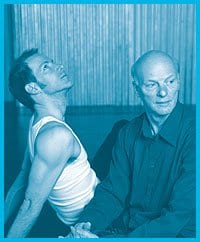Imagine being told that you had to retire at 35, regardless of the many years training for your vocation, and the few actually spent applying those lessons.
Welcome to the world of dance, where 25 is middle age and 30 is the cusp of professional oblivion (sounds sorta like the club circuit).
Two decades past his sell-by date, choreographer Paul-André Fortier stands in defiance of such ageism as he continues to create and perform exciting and poignant pieces like Tensions, appearing at the Premiere Dance Theatre on Fri, Apr 1 and 2.
Tensions is a remarkable commentary on aging and youth, an examination of our attitudes toward the powerful appeal of being young and vibrant and an illustration of the maturing body as it diminishes into something quieter and more thoughtful.
Two dancers share the stage, one in the subdued garb of the professional male, and one in the casual attire of the reckless, streetwise youth (tank-top aficionados take note). The older man moves with the assured solidity and efficiency expected of his age, systematically striding across the stage in crisp lines with forthright, metho-dical energy and no wasted flourish.
This is in stark contrast to the younger character’s effortless panache, as he restlessly explores each area of the performance space in clear celebration of his youthful dexterity and vigour. Where the older man seems to be repeating movements of familiarity and purpose, the younger co-opts and builds on them, eagerly experimenting as he pushes his body in unexpected, often erratic ways.
The piece moves at a brisk rhythmic pace, matched by Alain Thibault’s pulsing, at times, driving soundscape. Video by Patrick Masbouruian and John Munro’s lighting create an almost overwhelming environment in which the younger dancer grows increasingly bold and cocky, while his neighbour begins a gradual descent into fatigue and, finally, restfulness.
Each man seems solitary, despite occasional intersection onstage. It’s not so much a duet, but a coperformance of soloists, with the relationship between the two left purposefully ambiguous.
And while there’s a temptation to reduce an all-male piece to implied homoeroticism, the duality of Tensions seems to be one of youth and middle age, of what one was, and what one will become. The dancers could be facets of one individual: the younger a memory, or the older a projection.
Perhaps it is one man’s contemplation of mortality?
“People invest into it what they want, depending on who they are, where they are in their whole life, how they relate to other people,” Fortier says. “They project themselves into it.
“These are two solos: two men living at the same time, living under the pulse, the beat of the city. But some people see them as the same person, some as friends and some as father and son. It leaves room for everyone to invest their own idea.”
At 57, Fortier cuts an elegant swath onstage. Lean, graceful and in clear control of every movement, he nonetheless manages to capture the ominous pathos of advancing years, while still impressing with what is obviously a body in prime condition.
He began his dance career at the comparatively late age of 24 — a point where most dancers are reaching the peak of their prowess. Formerly a teacher of theatre and literature, Fortier joined the Nouvelle Aire dance group in the 1970s, creating lauded works such as Derrière la Porte un Mur and Parlez-moi donc du Cul de mon Enfance.
Fortier went on to found his own company, Fortier Danse-Création (formerly Danse-Théâtre Paul-André Fortier) in 1979, and was honoured with the Chalmers Award in 1981.
What followed was an exceptionally fertile period of choreography and performance, both as a soloist and as part of his group compositions. A career highpoint came with his dance trilogy, beginning with the solo piece Les Males Heures, and continuing with La Tentation de la Transparence and Bras de Plomb — the latter two pieces collaborative efforts with renowned visual artist Betty Goodwin.
“I worked with Betty Goodwin in her 70s, and she was stronger than most artists I know,” says Fortier. “[There was] a vigour in her ideas that was so extraordinary… it was a lesson to me, telling me that you have to be patient. It takes time to learn your craft, and then to polish your thoughts and ideas and be able to deliver them. It’s a lifetime commitment.
“Society tries to commercialize art and the creators, and there is a point that we forget there is a human being behind. If we want something consistent, we need to develop a body of work. It was one of the greatest lessons of my life.”
Guest teaching positions at The School Of Toronto Dance, Winnipeg Contemporary Dance School and Simon Fraser University offer chances for Fortier to share his experience and innovation while inspiring emerging young artists.
Fortier elicits both admiration and awe in the artists around him.
“It’s very inspiring,” says Eric Beau-chesne, who dances the role of the younger man in Tensions. “It’s almost a challenge to see somebody with so much enthusiasm and still in good shape. He’s 57, and doing an hour show onstage, full out — and it’s still very interesting to watch. He goes against the theory about aging and dancing.
“As a dancer you always hear, ‘At 35 it’s over.’ So when you get to 30, you’re like, ‘Oh, it’s the beginning of the end.’ Being with somebody like this just breaks those stereotypes. It opens a new door, somehow, about dancing.”
Beauchesne took over the role from Robert Meilleur this year, after a long association with Ballets Jazz de Montreal. While feeling some nervousness at having to learn the show in just three weeks prior to a Tokyo performance, he was quickly put at ease by Fortier’s company.
“Being onstage with Paul-André is amazing,” says Beauchesne. “It was very natural from the start. I didn’t have much time to know him, but at the same time it feels like he’s an old friend. He has this ability to make people feel comfortable around him.”
Music is an intrinsic element to Tensions, its pulsing throb an insistent force that pulls and pushes the dancers, heightening the static feeling coming from the stage. Composer Alain Thibault has worked on several Fortier creations, and collaborates closely with the choreographer in crafting the piece.
“I go to a couple of rehearsals,” Thibault explains, “and [Fortier] does a videotape of a version. I try to remember the feeling I had about the piece, work with the music and look to the video… so I can create something that floats over the dance.
“What’s interesting with Paul-André is that he’s giving also this liberty to the people who create the lights and the video, so it’s like an elemental piece. Your attention is always moving from dance, to music, to lights… that’s something I really appreciate.”
After finishing the current tour for Tensions, Fortier will premiere his group composition Lumière in Montreal this April. It’s a hectic schedule, but the choreographer has no intention of slowing down.
”I’m just happy to work,” he says. “I have no retirement plan whatsoever. I hope that I’ll have enough work to keep going and to be pertinent.”
With little downtime, a country home away from his Montreal residence offers solitude and peace for the ever-busy Fortier. The gay artist prefers to keep his private life, private. “There is the stage life and there is the personal life,” he says, “and the personal life is very ordinary.”
He remains philosophical on his own groundbreaking role in modern dance, and muses on the changing roles within the art form.
“In dance the career was very short because the technique was so demanding on the body; there weren’t roles for mature dancers. Now I think that in the world of contemporary dance it seems like every type of body can be expressive and charged with emotions.
“I strongly believe there is a poetry in the aging body that is as moving and as touching as what we find in the juvenile body. Of course the body fades a bit, but it gains other things that are so exciting.
“It’s very demanding, but when you have passion for what you’re doing it’s not a big deal.”
TENSIONS.
$24. 8pm. Fri, Apr 1 & 2. Premiere Dance Theatre.
207 Queens Quay W. (416) 973-4000.

 Why you can trust Xtra
Why you can trust Xtra


